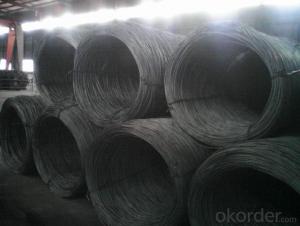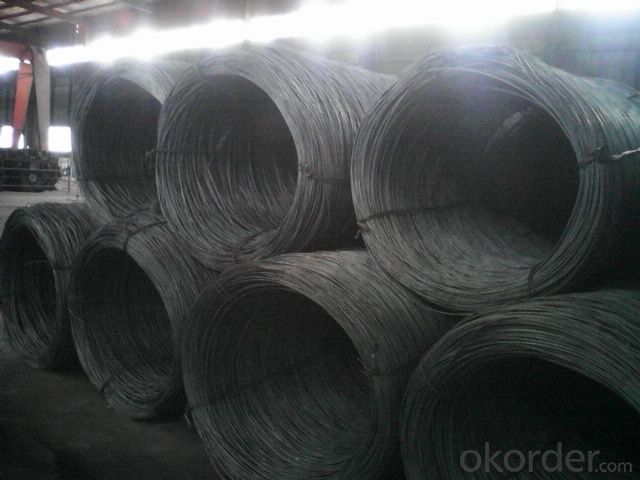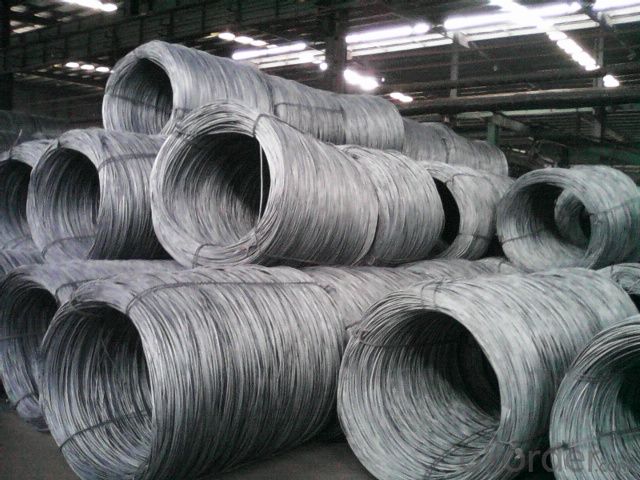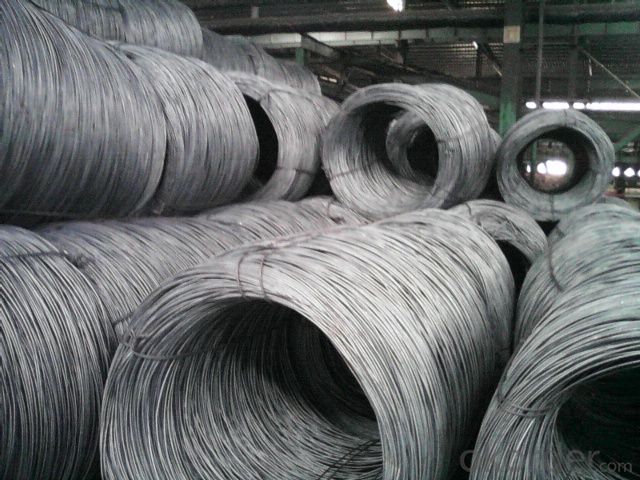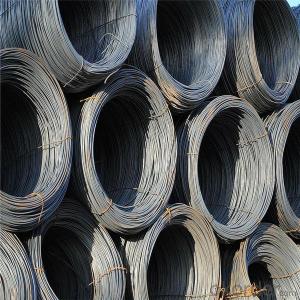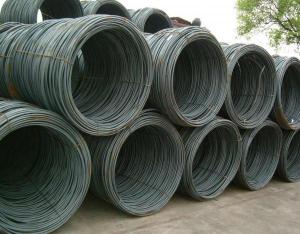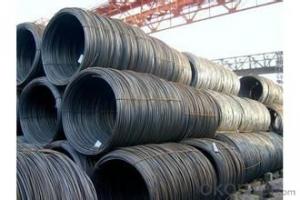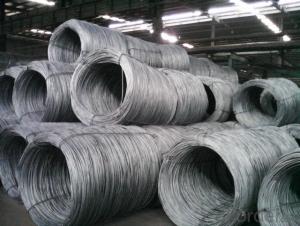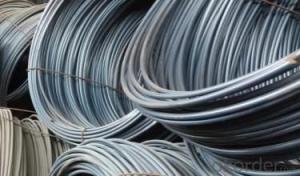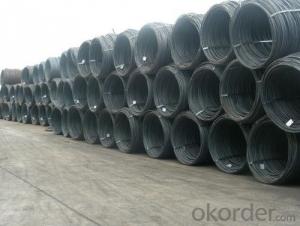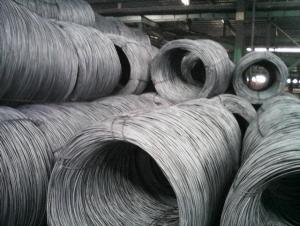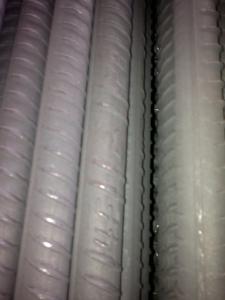Hot Rolled Steel Wire Rod AISI/ASTM/DIN/BS/GB/JIS
- Loading Port:
- Tianjin
- Payment Terms:
- TT OR LC
- Min Order Qty:
- 25 m.t.
- Supply Capability:
- 30000 m.t./month
OKorder Service Pledge
OKorder Financial Service
You Might Also Like
Specification
Product Description:
OKorder is offering Hot Rolled Steel Wire Rod AISI/ASTM/DIN/BS/GB/JIS at great prices with worldwide shipping. Our supplier is a world-class manufacturer of steel, with our products utilized the world over. OKorder annually supplies products to European, North American and Asian markets. We provide quotations within 24 hours of receiving an inquiry and guarantee competitive prices.
Product Applications:
Hot Rolled Steel Wire Rod AISI/ASTM/DIN/BS/GB/JIS are ideal for structural applications and are widely used in the construction of buildings and bridges, and the manufacturing, petrochemical, and transportation industries.
Product Advantages:
OKorder's Hot Rolled Steel Wire Rod AISI/ASTM/DIN/BS/GB/JIS are durable, strong, and resist corrosion.
Main Product Features:
· Premium quality
· Prompt delivery & seaworthy packing (30 days after receiving deposit)
· Corrosion resistance
· Can be recycled and reused
· Mill test certification
· Professional Service
· Competitive pricing
Product Specifications:
Steel Grade: Q195 Standard: ASTM, GB
Diameter: 5.5mm, 6.5mm, 7mm,8mm,9mm,10mm,12mm,14mm
6.5mm can be drawing into 2mm/8.0mm can be drawing into 3mm
Type: Drawn Wire in Coil, each coil weight about 2MT
Brand Name: N-RIVER Place of Origin: Hebei, China
Chemical Composition:
Please kindly find our chemistry of our material based on Q195 as below for your information
Trademark | Rank | Chemical composition (quality score) % | |||||
C | Si | Mn | S | P | |||
| ≤ |
| ≤ | ≤ | |||
Q195 |
| 0.06-0.12 | 0.30 | 0.25 | 0.050 | 0.045 | |
Trademark | Rank | Pulling Test | |||||
Bend PointΔs/Mpa | Tensile Strength | Elongation Ratioδ5% | |||||
Thickness (Diameter) /MM | Thickness (Diameter) /MM | ||||||
≤16 | 16-40 | ≤16 | 16-40 | ||||
≥ | ≥ | ||||||
Q195 |
| 195 | 185 | 315-390 | 33 | 32 | |
Packaging & Delivery of Wire Rod SAE1008B:
Packaging Detail: products are packed in coil and then shipped by container or bulk vessel
Each coil weight: 2-3MT
Delivery Detail: within 45 days after received deposit or LC.
Label: to be specified by customer, generally, each bundle has 1-2 labels
Trade terms: CFR, CIF
FAQ:
Q1: Why buy Materials & Equipment from OKorder.com?
A1: All products offered byOKorder.com are carefully selected from China's most reliable manufacturing enterprises. Through its ISO certifications, OKorder.com adheres to the highest standards and a commitment to supply chain safety and customer satisfaction.
Q2: How do we guarantee the quality of our products?
A2: We have established an advanced quality management system which conducts strict quality tests at every step, from raw materials to the final product. At the same time, we provide extensive follow-up service assurances as required.
Q3: How soon can we receive the product after purchase?
A3: Within three days of placing an order, we will begin production. The specific shipping date is dependent upon international and government factors, but is typically 7 to 10 workdays.
Q4: What makes stainless steel stainless?
A4: Stainless steel must contain at least 10.5 % chromium. It is this element that reacts with the oxygen in the air to form a complex chrome-oxide surface layer that is invisible but strong enough to prevent further oxygen from "staining" (rusting) the surface. Higher levels of chromium and the addition of other alloying elements such as nickel and molybdenum enhance this surface layer and improve the corrosion resistance of the stainless material.
Q5: Can stainless steel rust?
A5: Stainless does not "rust" as you think of regular steel rusting with a red oxide on the surface that flakes off. If you see red rust it is probably due to some iron particles that have contaminated the surface of the stainless steel and it is these iron particles that are rusting. Look at the source of the rusting and see if you can remove it from the surface.
Images:
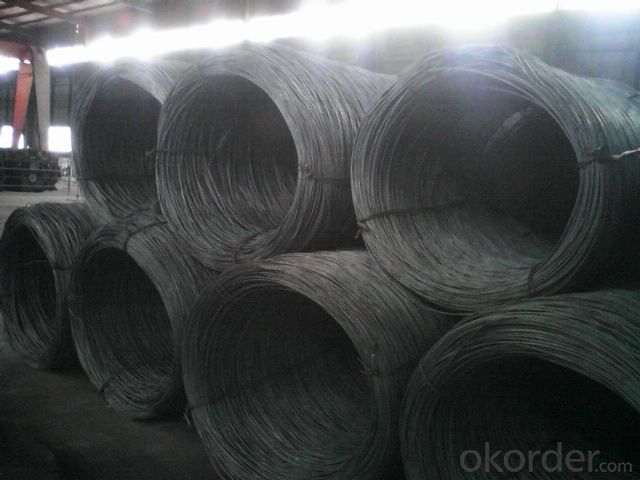
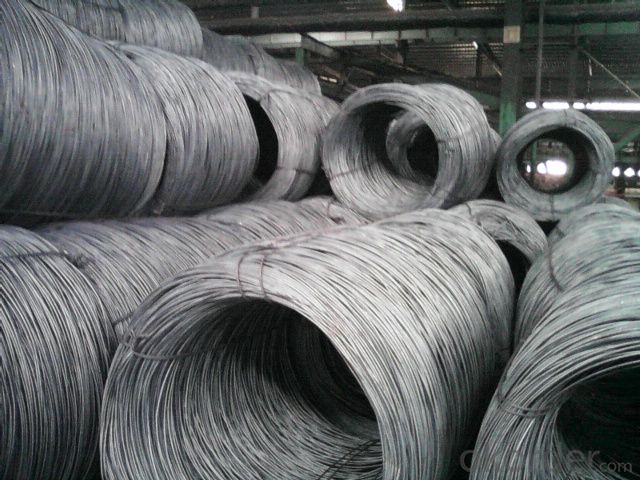
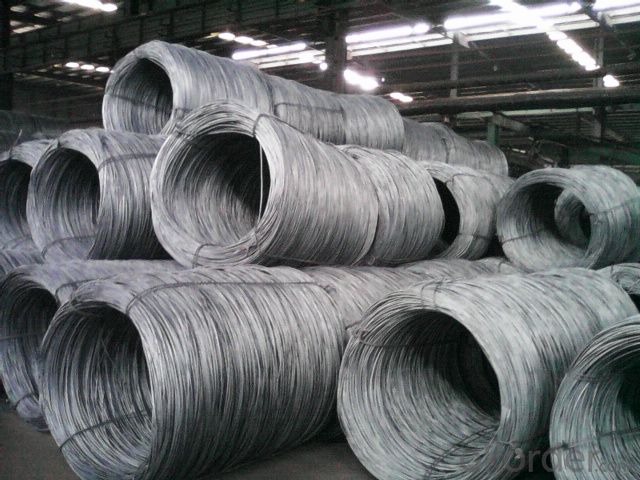
- Q: How are steel wire rods used in the production of wire coat hangers for hanging clothes?
- The durability and strength of steel wire rods make them essential for producing wire coat hangers used to hang clothes. These rods are the primary material for creating the frame and shape of the hangers. To begin, the steel wire rods are cut into the desired length for the coat hangers, ensuring the appropriate size for hanging clothes. Specialized machinery is then used to bend and shape the rods into the classic triangular form commonly associated with coat hangers. Next, the ends of the wire rods are smoothed and rounded off to prevent any sharp edges that could potentially damage clothing. This step is crucial for ensuring the safety of the hangers and avoiding harm to the garments being hung. Once the wire rods have been shaped and smoothed, they undergo a protective coating process, typically using plastic or rubber. This coating serves multiple purposes. Firstly, it prevents rusting or corrosion, ensuring the longevity of the hangers. Additionally, it provides a non-slip surface that helps prevent clothes from slipping off. Finally, the coated wire rods are securely attached to a separate hook at the top, allowing the hangers to be hung on a closet rod or any suitable hanging mechanism. This hook is usually made of either plastic or metal and ensures the stability and functionality of the coat hanger. Overall, steel wire rods are vital in the production of wire coat hangers, providing the necessary strength, durability, and shape for hanging clothes. Their versatility and ability to be shaped and coated make them an ideal material for creating reliable and long-lasting hangers.
- Q: What are the different types of steel wire rod surface defect monitoring systems?
- Some of the different types of steel wire rod surface defect monitoring systems include visual inspection systems, laser scanning systems, ultrasonic inspection systems, and magnetic particle inspection systems. These systems are used to detect and evaluate surface defects such as cracks, pits, scratches, and other abnormalities in steel wire rods.
- Q: How does the fatigue strength of steel wire rod vary with different wire drawing processes?
- The specific wire drawing process utilized can lead to varying fatigue strengths in steel wire rods. Wire drawing, a metalworking procedure that involves pulling a metal wire through a die to decrease its diameter and increase its length, is the key process. There are multiple wire drawing processes available, including wet drawing, dry drawing, and intermediate drawing, each having distinct characteristics and impacts on the fatigue strength of the steel wire rod. One factor that affects fatigue strength is the lubrication employed during the wire drawing process. Wet drawing entails immersing the wire rod in a lubricant to decrease friction and heat generation. This lubrication aids in minimizing surface defects and improving the fatigue strength of the wire rod. Conversely, dry drawing does not entail any lubrication, which can result in increased friction and heat generation, potentially leading to a decrease in fatigue strength. The reduction ratio, the ratio of the initial wire diameter to the final wire diameter, also plays a vital role. Higher reduction ratios can enhance the fatigue strength of the wire rod as the process aligns the grain structure and improves overall mechanical properties. However, excessively high reduction ratios can introduce internal defects or residual stresses, which can have a negative impact on fatigue strength. The subsequent heat treatment process after wire drawing can significantly influence fatigue strength as well. Heat treatment techniques, such as annealing or quenching, can enhance the microstructure of the wire rod and improve its fatigue strength. Annealing helps alleviate internal stresses and refine the grain structure, while quenching provides increased hardness and strength. These heat treatment processes can compensate for any potential reduction in fatigue strength caused by the wire drawing process. In conclusion, the fatigue strength of steel wire rod can vary depending on the wire drawing process employed. Factors such as lubrication, reduction ratio, and heat treatment techniques all have an impact on fatigue strength. It is crucial to carefully select the appropriate wire drawing process and associated parameters to optimize the fatigue strength of the steel wire rod for specific applications.
- Q: What are the safety considerations for using steel wire rod in construction?
- Some safety considerations for using steel wire rod in construction include ensuring proper handling and storage to prevent injuries, using appropriate personal protective equipment such as gloves and safety glasses, conducting regular inspections to check for any defects or damage in the wire rod, and following proper installation techniques to ensure structural integrity and prevent accidents.
- Q: How is steel wire rod used in the manufacturing of wire for suspension bridges?
- Steel wire rod is used in the manufacturing of wire for suspension bridges as it serves as the primary raw material. The wire rod is first drawn through a series of dies to reduce its diameter and increase its strength. This process, known as wire drawing, transforms the rod into a long, thin wire with desired mechanical properties. The resulting wire is then further processed and woven into intricate cable systems, which form the main load-bearing elements of suspension bridges. The high tensile strength and durability of steel wire make it a crucial component in ensuring the structural integrity and stability of suspension bridges, allowing them to withstand heavy loads and span long distances.
- Q: How is steel wire rod used in the manufacturing of wire displays?
- Steel wire rod is used in the manufacturing of wire displays as it serves as the primary material for creating the framework and structure of the displays. The steel wire rod is bent, shaped, and welded to form the desired design and size of the display, providing strength and durability to hold and showcase various products.
- Q: How is the corrosion resistance of steel wire rod improved?
- The corrosion resistance of steel wire rod can be improved through various methods and techniques. One common approach is through the use of protective coatings. Steel wire rods can be coated with materials such as zinc, aluminum, or other corrosion-resistant metals to create a barrier between the steel and corrosive elements in the environment. These coatings act as sacrificial layers that corrode instead of the steel, thus prolonging the lifespan of the wire rods. Another method to enhance corrosion resistance is through the process of galvanization. This involves immersing the steel wire rod in a bath of molten zinc, which forms a protective layer on the surface of the rod. This galvanized coating acts as a physical barrier against corrosion, as well as providing cathodic protection to the steel, further reducing the risk of corrosion. Moreover, alloying steel with certain elements can also improve its corrosion resistance. For instance, stainless steel wire rods are commonly used in applications where corrosion resistance is crucial. Stainless steel contains a high percentage of chromium, which forms a passive and self-repairing oxide layer on the surface of the steel, protecting it from corrosion. In addition to these methods, the surface finish of the steel wire rod can also play a role in enhancing its corrosion resistance. Smoother and more polished surfaces tend to have better resistance to corrosion than rougher surfaces, as they offer fewer crevices or imperfections for corrosive agents to penetrate. Regular maintenance and proper storage of steel wire rods are also essential for maintaining their corrosion resistance. This includes keeping them in dry environments, protecting them from exposure to moisture or corrosive substances, and promptly addressing any signs of corrosion, such as rust, through cleaning and applying appropriate corrosion inhibitors. Overall, improving the corrosion resistance of steel wire rods involves a combination of coating techniques, alloying, surface finishing, and proper maintenance to ensure their longevity and performance in corrosive environments.
- Q: What are the advantages of using steel wire rod in agricultural applications?
- Using steel wire rod in agricultural applications offers several advantages. Firstly, steel wire rod is known for its strength and durability, making it ideal for withstanding the harsh conditions found in agricultural environments. It can withstand heavy loads, resist corrosion, and endure extreme temperatures. Additionally, steel wire rod is highly flexible, allowing it to be easily shaped and manipulated for various agricultural purposes. Its versatility makes it suitable for applications such as fencing, trellising, and the construction of animal enclosures. Moreover, steel wire rod is cost-effective and widely available, making it a practical choice for farmers and agricultural businesses. Overall, the use of steel wire rod in agricultural applications provides the benefits of strength, durability, flexibility, versatility, and affordability.
- Q: What are the different types of wire mesh for automotive filters made from steel wire rod?
- There are several different types of wire mesh used for automotive filters that are made from steel wire rod. Some common types include plain weave mesh, twill weave mesh, and Dutch weave mesh. Each type of wire mesh has its own unique characteristics and is used for different applications within automotive filters.
- Q: How is steel wire rod coated for corrosion protection?
- Various methods are commonly employed to coat steel wire rods for corrosion protection. One such method involves the utilization of hot-dip galvanizing, where the wire rod is passed through a bath of molten zinc at a temperature of approximately 450 degrees Celsius. By doing so, the zinc coating effectively adheres to the surface of the wire rod, serving as a safeguard against corrosion. Another approach is electroplating, which entails immersing the wire rod in an electrolyte solution that contains zinc ions. Subsequently, an electric current is passed through the solution, leading to the bonding of the zinc ions with the wire rod's surface. This process engenders a uniform and long-lasting zinc coating that confers protection against corrosion. Furthermore, organic coatings such as paint or polymer coatings can be applied to wire rods. These coatings are administered through methods like spraying, dipping, or electrostatic deposition. By establishing a barrier between the steel wire rod and its surroundings, the organic coatings obstruct moisture and other corrosive agents from reaching the surface, thus averting corrosion. In summary, the choice of coating process for steel wire rods hinges upon specific requirements and intended applications. Factors such as the desired level of corrosion resistance, prevailing environmental conditions, and the wire rod's aesthetic preferences all contribute to determining the most suitable coating method.
Send your message to us
Hot Rolled Steel Wire Rod AISI/ASTM/DIN/BS/GB/JIS
- Loading Port:
- Tianjin
- Payment Terms:
- TT OR LC
- Min Order Qty:
- 25 m.t.
- Supply Capability:
- 30000 m.t./month
OKorder Service Pledge
OKorder Financial Service
Similar products
Hot products
Hot Searches
Related keywords
